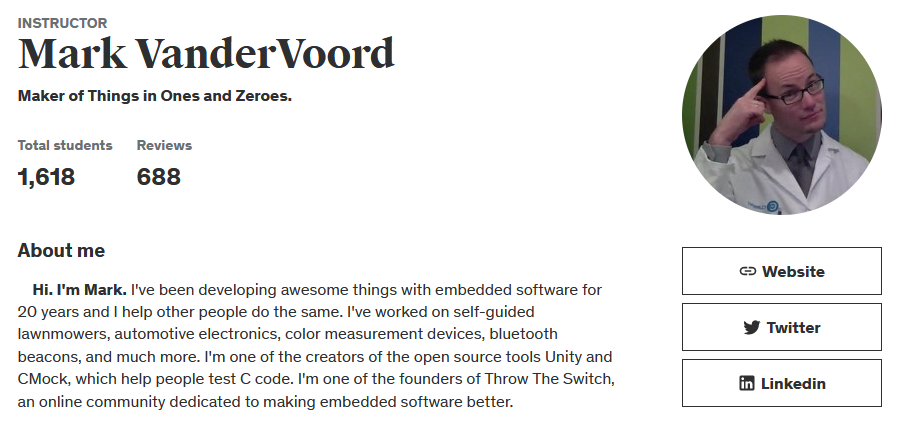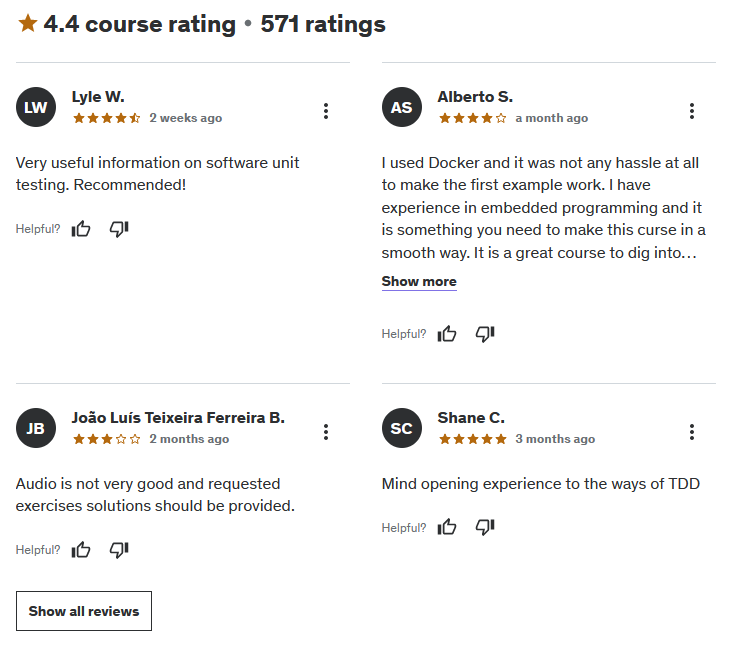Hey there, tech enthusiasts and aspiring mad scientists! If you’ve been tinkering with the idea of diving into the realm of unit testing and test-driven development (TDD) for embedded and system software in C, you might just be considering enrolling in Dr. Surly’s School for Mad Scientists. Well, you’re in luck because I’ve taken the plunge into this course titled “Unit Testing & Other Embedded Software Catalysts” on Udemy, and I’m here to share my unfiltered thoughts about it.
At first glance, the course promises to arm you with the skills to develop embedded and system software in C using unit tests, a venture into the test-driven development practices, and the production of quality software designs through test-first thinking. The whimsical introduction to Dr. Surly’s School for Mad Scientists sets a fun and engaging tone, inviting you to join a mission to “take over the world” with quality embedded software.
Instructor Reputation: The Architect Behind the Code
When we dive into the realm of online learning, the instructor’s reputation plays a pivotal role in the decision-making process. This is where Mark VanderVoord, our guide through the labyrinth of unit testing and test-driven development (TDD) for embedded software in C, stands as a beacon of knowledge and experience. With a solid instructor rating of 4.2, garnered from 688 reviews, and having enlightened 1,618 students across 2 courses, Mark’s credentials are not just numbers but testimonials of his impact and dedication.

But who is Mark VanderVoord, you might ask? Mark isn’t just another developer; he’s a craftsman in the world of ones and zeroes. With a career spanning over 20 years in embedded software development, Mark has had his hands in projects ranging from self-guided lawnmowers to automotive electronics and beyond. His experience isn’t confined to just building things; it’s about innovating, teaching, and sharing his vast knowledge with others. This commitment is further illustrated by his contributions to the open-source community through tools like Unity and CMock, which are pivotal in testing C code. These tools are not just pieces of software; they are Mark’s legacy, enabling developers worldwide to elevate their code’s quality and reliability.
Furthermore, Mark’s role as one of the founders of Throw The Switch, an online community dedicated to enhancing embedded software, speaks volumes about his passion for education and improvement in the field. This platform is not merely a repository of resources; it’s a gathering of like-minded individuals driven by the desire to make embedded software better under Mark’s leadership.
But beyond the accolades and contributions, what truly sets Mark apart as an instructor is his approachability and commitment to his students. Reviews often highlight not just the depth of knowledge he brings to the table but also his willingness to engage, explain, and enlighten. His instructional style bridges the gap between theoretical knowledge and practical application, making complex concepts accessible to beginners and veterans alike.
Course Structure: A Deep Dive into the Curriculum
Embarking on the journey of “Unit Testing & Other Embedded Software Catalysts” is akin to charting a course through unexplored territories, with each section of the course designed to build your knowledge and skills incrementally. The course’s architecture is meticulously crafted, encompassing 29 code-centered lectures, 5 development projects, and 18 supplemental resources packed with primers, guides, and how-tos. This comprehensive structure ensures a holistic learning experience, catering to various learning styles and preferences.

The code-centered lectures serve as the course’s backbone, offering a deep dive into the principles of unit testing and TDD in the context of embedded and system software in C. These are not your average, theoretical lectures; they are immersive sessions that encourage active learning through real, executable tests from the very first day. Mark’s teaching philosophy is evident here – to learn by doing. This hands-on approach demystifies the complexities of TDD, making it accessible and applicable to real-world scenarios.
Complementing the lectures, the development projects are where theory meets practice. Each project is carefully selected to reinforce the concepts discussed in the lectures, offering learners the opportunity to apply their newfound knowledge to tangible tasks. From writing unit tests to implementing TDD practices, these projects simulate the challenges one might face in the industry, preparing students for the real world. However, feedback suggests that these projects could evolve to more closely mirror real-world complexities, presenting an opportunity for the course to grow and adapt to learners’ needs.
The supplemental resources are the course’s hidden gems, providing learners with additional insights, best practices, and troubleshooting tips. These resources are invaluable for those looking to deepen their understanding or navigate the occasional hurdles that come with learning something new. From primers on the Unity framework to guides on navigating common pitfalls in TDD, these resources ensure learners have the support they need to succeed.
Overall, the course’s structure is a testament to Mark VanderVoord’s expertise and dedication to education. It’s designed not just to impart knowledge but to inspire innovation and excellence in the field of embedded software development. Through this structured yet flexible curriculum, learners are equipped with the skills, confidence, and mindset to tackle the challenges of TDD and unit testing in C, paving the way for advancements in their personal and professional endeavors.
Content Quality: Rigor Meets Real-World Relevance
In the vast ocean of online courses, the quality of content is what distinguishes a worthwhile learning journey from a forgettable one. In “Unit Testing & Other Embedded Software Catalysts,” the content quality shines through a curriculum meticulously designed to balance rigor with real-world relevance. This course not only promises to teach the fundamentals of unit testing and Test-Driven Development (TDD) but delivers on this promise by immersing learners in the depths of embedded and system software development in C.

The curriculum’s backbone, its code-centered lectures, goes beyond mere theory to provide actionable insights and hands-on experience from the get-go. Each lecture is structured to build on the previous, gradually increasing in complexity but never at the expense of clarity. The use of the Unity framework as a teaching tool is particularly noteworthy. Unity is not presented as just another tool but as a companion in the journey of learning TDD, with detailed explanations on its application in various testing scenarios. This approach ensures that learners not only understand the “how” but also grasp the “why” behind each test case, fostering a deeper understanding of the principles of TDD.
However, the course’s content quality truly shines in its practical application through development projects. These projects are ingeniously designed to challenge learners, requiring them to apply the concepts learned in lectures to solve real-world problems. Although some feedback suggests these projects could be more reflective of the complexities encountered in professional settings, they nonetheless serve as an effective bridge between learning and doing. This practical component is crucial, as it equips learners with the skills and confidence to apply TDD and unit testing in their projects, thereby enhancing their employability and effectiveness as developers.
Despite its strengths, the course is not without areas for improvement. Some learners have expressed a desire for more guidance on determining the necessary number of tests, indicating a potential gap in bridging theory with practice regarding test coverage and edge cases. Addressing this feedback could elevate the course’s content quality even further, providing learners with a more nuanced understanding of testing strategies.
Overall Course Rating: 8.5/10
After thoroughly engaging with the course material, interacting with the community, and considering feedback from fellow learners, I’m ready to give “Unit Testing & Other Embedded Software Catalysts” an overall rating. Taking into account the depth and breadth of the content, the instructor’s expertise and engagement, the practical application through development projects, and the supplemental resources provided, my overall course rating is an 8.5 out of 10.

This rating reflects the course’s strong foundation in teaching unit testing and TDD for embedded software in C, with content that expertly balances technical rigor with practical relevance. The instructor, Mark VanderVoord, brings invaluable expertise and a passionate teaching style, significantly enhancing the learning experience. The course structure, with its mix of lectures, projects, and resources, is thoughtfully designed to support learners at every step of their journey.
However, the rating also acknowledges room for improvement, particularly in the complexity of development projects and the clarity around testing strategies. Enhancing these aspects could make the course even more robust, offering learners an even closer approximation of the challenges and complexities of real-world software development.
In conclusion, “Unit Testing & Other Embedded Software Catalysts” stands out as a valuable resource for C developers seeking to master unit testing and TDD. Whether you’re looking to improve the quality of your code, enhance your problem-solving skills, or simply take your first steps into the world of embedded software development, this course offers a comprehensive, engaging, and rewarding learning experience. With the feedback and potential areas for improvement in mind, there’s no doubt that this course will continue to evolve and remain a vital resource for aspiring and experienced developers alike.



